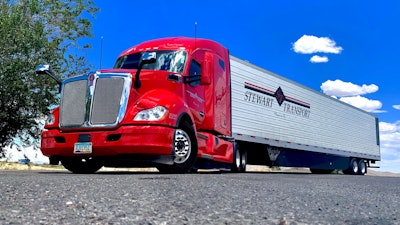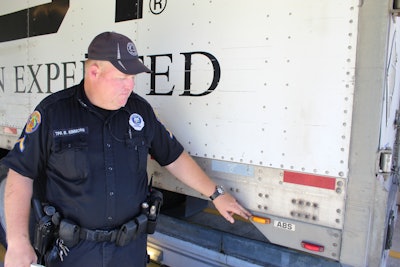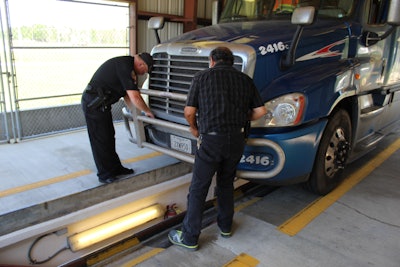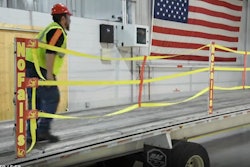
Truck cameras have become so important to fleet safety that trucking insurance expert Sam Tucker believes the Federal Motor Carrier Safety Administration will be mandating their use.
“I hate to look into my crystal ball and think that's the case but I really do. I honestly do,” Tucker, CEO of Carrier Risk Solution, said during Truckload Carriers Association’s webinar on improving carrier standing with insurers, April 15.
Mandate or not, more fleets are leaning on event recorders, Tucker said, especially at a time when costly crash verdicts are dragging carriers into news headlines.
“It's the next big wave,” Tuckers said of truck-mounted cameras. “Even a lot of owner-operators who may not have the ability to have full bore systems in their trucks are going to Amazon and grabbing up a $35 dash cam because they understand the power behind it. I think it's really, from a grassroots perspective, building up.”
[Related: Driver-facing cameras headed down a path of least resistance]
Stewart Transport, a reefer and custom freight hauler based in Phoenix, Ariz., is no stranger to safety. The 25-year-old carrier, which covers the lower 48 states, was recognized as the safest fleet by the Arizona Trucking Association in 2015.
Stewart Transport Risk Management Director Amanda Gallegos, another panelist on the TCA Truckload Academy webinar, said that having cameras in trucks has helped on various levels.
“Adding our camera system was pretty much the key to getting a really true, unbiased narrative on what's going on,” she said. “We have been able to advocate for our drivers that were falsely accused. But on the flip side we've also been able to manage claims where we knew we were at liability just by kind of concentrating on that unbiased narrative.”
 To help maintain great CSA scores and keep insurance companies happy, Sam Tucker, CEO of Carrier Risk Solutions, recommends keeping up with pre- and post-trip inspections. "Lighting is the number one violation out there across all fleets," Tucker said. "If you can do anything to prevent lighting violations. That's the number one key."Tom Quimby
To help maintain great CSA scores and keep insurance companies happy, Sam Tucker, CEO of Carrier Risk Solutions, recommends keeping up with pre- and post-trip inspections. "Lighting is the number one violation out there across all fleets," Tucker said. "If you can do anything to prevent lighting violations. That's the number one key."Tom Quimby
“Oftentimes drivers and other parties bring an emotional narrative to the situation, but the cameras take that emotional part out and we're able to process claims quicker,” she said.
Kristin Tedesco, senior marketing manager at Netradyne, which sponsored TCA’s webinar, said the stress of an accident can impact memory recall.
“We find that people don't always remember what happened, especially in a really stressful situation like an accident,” she said. “I think that camera really can take the pressure off of the driver for having to remember and recall what just happened.”
Having drivers review video evidence prior to giving a statement on an accident can prove helpful.
“A lot of times we've even seen where it's not necessarily becoming beneficial to take a driver's statement immediately after the crash,” Tucker said. “To begin with, we have telematics and the camera system to tell us exactly what happened or to the best of our knowledge.
“Before we take an official recorded statement, we compare all the information that we have to begin with and say (to the driver), 'Hey, help me paint this picture, help me fill this in and understand a little bit better about what's going on here,’” Tucker continued.
Video evidence has also helped Stewart Transport coach drivers because it brings a balanced approach, Gallegos said. Managers can initially point out positive aspects of driver performance before addressing concerns. Tedesco applauded carriers that use this two layered approach.
“That’s why our engineering team designed the cameras the way they did,” she said. “Since it captures the entire day, you look at the pie chart of how much risky driving there’s been versus good driving and most of it is good. So focusing on that, I think, is a great way to start and really just say, ‘You're doing awesome. Here's what you can work on.’”
Tucker said insurance companies continue to see the value in having cameras on trucks.
"It's kind of the underwriters ideal dream if they have cameras in the trucks and a solid ELD telematics platform underneath it to support it," he said.
Prioritize and educate
In addition to cameras, Tucker pointed out how automatic braking and collision avoidance systems reduce a carrier's risk. Plus, telematics and ELDs have brought on a tidal wave of data to consider for fine-tuning fleet safety management.
“More than any time in our history as an industry we've had unprecedented technology in a truck to be right there alongside the drivers,” he said.
However, with a flood of driver performance data continually pouring in, it’s important to make sense of it all to keep safety managers and drivers alike from being overwhelmed.
[Related: Dash cameras evolve with AI for facial recognition, driver self-coaching]
“We looked at our CSA scores, our weaknesses and our claims and said, ‘Okay, these three top behaviors are negatively affecting our claims. They're negatively affecting our safety program,” Stewart Transport's Gallegos said.
Looking over driver data can be like “drinking from a fire hose,” Gallegos continued. “So, you have to be able to say, ‘Hey, listen. These are our three weaknesses. This is where we’re going to narrow it down and get on that granular level. So I would say, take a look at your CSA scores, take a look at your claims, see where the weak spots are. That's how we started, and then you can just add as you go.”
Tucker and Tedesco agreed.
 Stewart Transport focuses on preparing their drivers for roadside inspections. “The fastest and easiest thing that we have found to reduce our risk is to really educate our drivers specifically during roadside inspections and what the results of the roadside inspections are to our CSA (compliance, safety, accountability) scores and their own PSP (pre-employment screening program) scores,” Stewart Transport Risk Management Director Amanda Gallegos said.Tom Quimby
Stewart Transport focuses on preparing their drivers for roadside inspections. “The fastest and easiest thing that we have found to reduce our risk is to really educate our drivers specifically during roadside inspections and what the results of the roadside inspections are to our CSA (compliance, safety, accountability) scores and their own PSP (pre-employment screening program) scores,” Stewart Transport Risk Management Director Amanda Gallegos said.Tom Quimby
Getting buy-in for safety goals from drivers proved to be a critical part of the process for Stewart Transport.
“The fastest and easiest thing that we have found to reduce our risk is to really educate our drivers specifically during roadside inspections and what the results of the roadside inspections are to our CSA (compliance, safety, accountability) scores and their own PSP (pre-employment screening program) scores,” Gallegos said.
“We often find that drivers don't understand their PSP scores and they don't understand the impact of the CSA. So right out of orientation in the beginning, we start that education. We get them empowered to understand safety issues right from the get-go and then we continue to train throughout the year.”
One issue that’s come up and has required driver training is cell phone use — and not just from the point of distracted driving.
“We pushed ELD really fast,” Gallegos said. “I think the technology went way faster than what some of our drivers were ready for and so we see this violation a lot here in Arizona where the drivers are using their ELD on their phones and not having the phone mounted to the dash.
“It’s one of those new regulations that we're getting dinged on. And so we try to do everything we can to promote putting the phone up on the dash and we try not to bother them while they're running on the road.”











